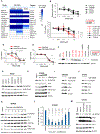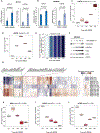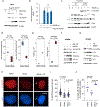H2A.Z histone variants facilitate HDACi-dependent removal of H3.3K27M mutant protein in pediatric high-grade glioma cells
- PMID: 38306270
- PMCID: PMC11026119
- DOI: 10.1016/j.celrep.2024.113707
H2A.Z histone variants facilitate HDACi-dependent removal of H3.3K27M mutant protein in pediatric high-grade glioma cells
Abstract
Diffuse intrinsic pontine gliomas (DIPGs) are deadly pediatric brain tumors, non-resectable due to brainstem localization and diffusive growth. Over 80% of DIPGs harbor a mutation in histone 3 (H3.3 or H3.1) resulting in a lysine-to-methionine substitution (H3K27M). Patients with DIPG have a dismal prognosis with no effective therapy. We show that histone deacetylase (HDAC) inhibitors lead to a significant reduction in the H3.3K27M protein (up to 80%) in multiple glioma cell lines. We discover that the SB939-mediated H3.3K27M loss is partially blocked by a lysosomal inhibitor, chloroquine. The H3.3K27M loss is facilitated by co-occurrence of H2A.Z, as evidenced by the knockdown of H2A.Z isoforms. Chromatin immunoprecipitation sequencing (ChIP-seq) analysis confirms the occupancy of H3.3K27M and H2A.Z at the same SB939-inducible genes. We discover a mechanism showing that HDAC inhibition in DIPG leads to pharmacological modulation of the oncogenic H3.3K27M protein levels. These findings show the possibility of directly targeting the H3.3K27M oncohistone.
Keywords: CP: Cancer; DIPG; H2A.Z; H3.3; H3.3K27M; HDAC inhibitors; SB939; histone variants; multiomics; pediatric high-grade gliomas.
Copyright © 2024 The Author(s). Published by Elsevier Inc. All rights reserved.
Conflict of interest statement
Declaration of interests J. Mieczkowski is a co-founder of and shareholder in Genegoggle.
Figures





References
Publication types
MeSH terms
Substances
Grants and funding
LinkOut - more resources
Full Text Sources
Medical
Molecular Biology Databases
Miscellaneous

